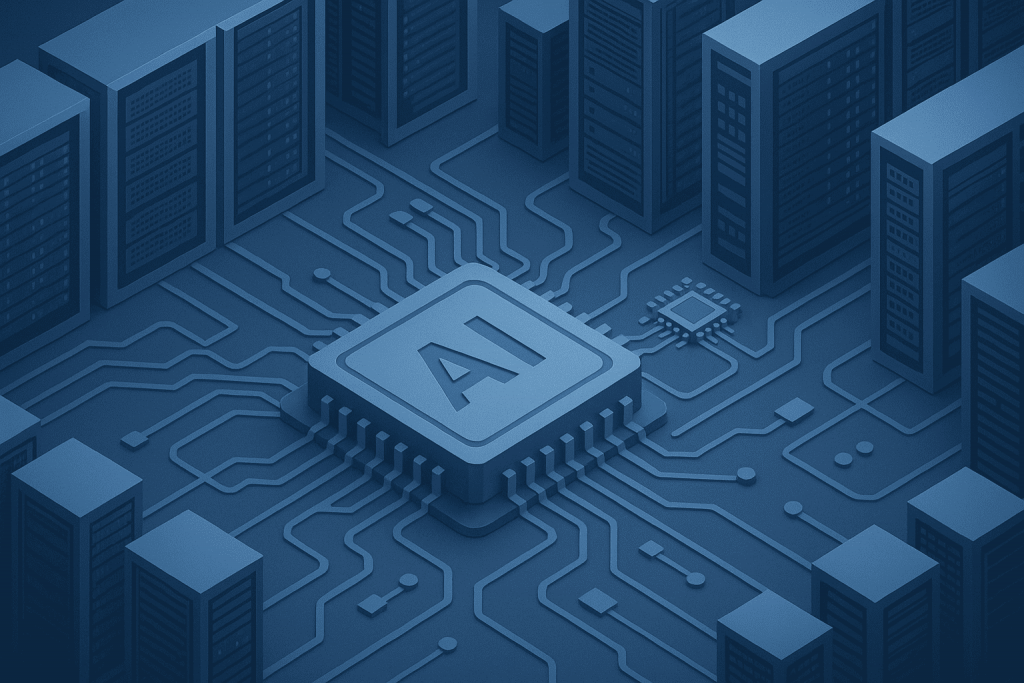
The rapid progress of artificial intelligence has forced the data center industry to radically restructure: classical server farms must transform into AI-oriented “supercenters” with supercomputer-level power and new infrastructure requirements. At the core of these changes are specialized AI accelerators — hardware chips designed to speed up machine learning tasks, which have essentially become the foundation of modern data center architecture. Without such accelerators, breakthroughs like ChatGPT would take much more time and money — no wonder AI accelerators are now widely used by global tech giants.
What AI Accelerators Are and Why They Are Needed
The term “AI accelerator” includes various hardware solutions (for example, graphics processors GPU, tensor processors TPU, or neural processors NPU) designed for ultra-fast execution of artificial intelligence computations. Unlike universal CPUs, such accelerators are engineered with a focus on massive parallelism: they can perform billions of mathematical operations simultaneously, optimized for deep learning algorithms. This allows efficient processing of huge datasets required for training neural networks, which would be overwhelming for traditional processors. Essentially, AI accelerators became the industry’s response to the explosive growth of AI workloads — it is thanks to them that modern deep learning models can be trained and used within reasonable timeframes.
How AI Accelerators Change Data Center Architecture
Deploying hundreds of accelerators in a data center drastically affects its engineering infrastructure. First of all, energy consumption increases sharply: while a traditional server rack consumed 5–10 kilowatts, a rack filled with AI servers powered by GPUs may require 40–100+ kilowatts. Therefore, cabinets containing dozens of such accelerators generate so much heat that standard air cooling is no longer sufficient. AI centers implement advanced heat dissipation solutions: liquid cooling of servers (through special circuits or even immersion in dielectric liquid) becomes a necessity, while traditional air conditioning and ventilation act only as supplementary systems.
Network architecture also changes: to ensure parallel operation of thousands of accelerators, high-speed communication channels with minimal latency are required. Standard Ethernet in such scenarios is often replaced with specialized interconnects such as InfiniBand; the number of fiber-optic connections in racks increases multiple times to allow all accelerators to exchange data at high speed. In essence, an AI data center resembles a supercomputer cluster: everything — from power supply and cooling schemes to network topology — is optimized for massive parallel computation. Traditional server farms that fail to modernize in time risk quickly becoming outdated amid the rapid growth of AI workloads.
Example: Fairwater AI — Microsoft’s Next-Generation Data Center
Microsoft is completing the construction of its first AI data center, Fairwater, in Mount Pleasant (Wisconsin) — a multi-billion-dollar project totaling over $7 billion across two phases.
Fairwater AI is designed around an enormous volume of computing resources: hundreds of thousands of NVIDIA graphics processors are united into a single seamless cluster, with optical cables running between them in total length sufficient to wrap around the Earth four times. In fact, this center will operate as one giant supercomputer, delivering performance 10 times greater than the fastest modern supercomputer. Such power is primarily intended for training next-generation advanced artificial intelligence models.
Despite the enormous concentration of hardware, Fairwater AI is built with a focus on energy efficiency: 90% of the cooling system uses a closed liquid loop, while the remainder relies on outside air (water is used only during heat waves), so its annual water consumption will not exceed that of an average restaurant. In addition to technical innovations, the project also has a social impact: the data center will provide the region with hundreds of new jobs and stimulate the development of IT education (Microsoft has already opened a specialized academy in the state to train personnel).
Conclusions
AI accelerators have become the heart of modern data centers, opening new horizons of performance. As AI continues to spread, companies around the world are rethinking their infrastructure to adapt it to high-performance computing with minimal latency. For everyday users, this means faster development of new digital services — from smart assistants to medical systems — as powerful AI centers like Fairwater lay the foundation for the next technological leap.

Luna
AI accelerators at the core of modern data centers are reshaping the landscape in a really exciting way. It’s heartening to imagine these smarter hubs powering the next wave of ML innovations.